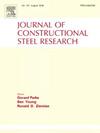Testing and analysis on out-of-plane buckling behavior of concrete-filled steel tubular arch
IF 4
2区 工程技术
Q1 CONSTRUCTION & BUILDING TECHNOLOGY
引用次数: 0
Abstract
Long-span concrete-filled steel tubular (CFST) arches have gained widespread use due to their high strength, excellent seismic resistance, and ease of construction. However, long-span CFST arches are susceptible to out-of-plane buckling problem. In addition, experimental studies on out-of-plane buckling behavior of CFST arches remains limited. In that perspective, this study investigates the buckling behavior of a 9-m span CFST parabolic fixed arch. The arch has a circular cross-section and was subjected to uniformly distributed tilting loads. The effects of the residual stress on the buckling behavior of the composite arches were examined by building finite element models with solid elements. The influence of the confinement effects on the buckling response of the arches was then examined using models with simplified beam elements. It was found that the residual stress had limited effect on the buckling behavior of the arches. The confinement effect had insignificant influence on the buckling behavior of the arches with large slenderness ratios subjected to distributed tilting loads, while it became substantial for arches with low slenderness ratios. The model's accuracy was validated against the experimental data, and the comparative results demonstrated its capability to reliably predict the buckling behavior of CFST arches.
钢管混凝土拱面外屈曲性能试验与分析
大跨度钢管混凝土拱以其高强度、优异的抗震性能和施工方便等优点得到了广泛的应用。然而,大跨度钢管混凝土拱容易出现面外屈曲问题。此外,对钢管混凝土拱的面外屈曲行为的试验研究仍然有限。从这个角度来看,本研究研究了9米跨度CFST抛物线固定拱的屈曲行为。拱具有圆形截面,并承受均匀分布的倾斜荷载。通过建立实体单元有限元模型,研究了残余应力对复合拱桥屈曲行为的影响。采用简化梁单元模型分析了约束效应对拱屈曲响应的影响。结果表明,残余应力对拱的屈曲行为影响有限。约束效应对大长细比拱在分布倾斜荷载作用下的屈曲行为影响不大,而对低长细比拱的屈曲行为影响较大。通过与试验数据的对比,验证了该模型的准确性,验证了该模型能够可靠地预测钢管混凝土拱的屈曲行为。
本文章由计算机程序翻译,如有差异,请以英文原文为准。
求助全文
约1分钟内获得全文
求助全文
来源期刊

Journal of Constructional Steel Research
工程技术-工程:土木
CiteScore
7.90
自引率
19.50%
发文量
550
审稿时长
46 days
期刊介绍:
The Journal of Constructional Steel Research provides an international forum for the presentation and discussion of the latest developments in structural steel research and their applications. It is aimed not only at researchers but also at those likely to be most affected by research results, i.e. designers and fabricators. Original papers of a high standard dealing with all aspects of steel research including theoretical and experimental research on elements, assemblages, connection and material properties are considered for publication.
 求助内容:
求助内容: 应助结果提醒方式:
应助结果提醒方式:


